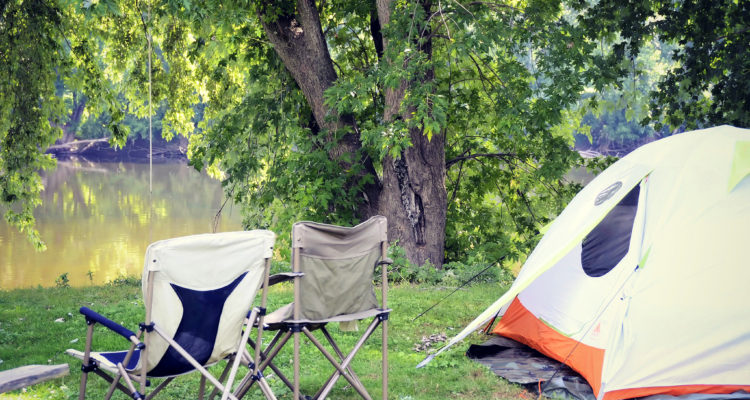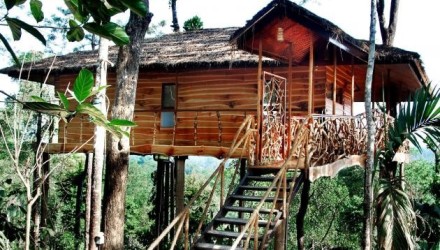I was asked to describe my “actions” in picking and setting up my primitive tent camp site when I knew there was a good possibility of thunderstorms. Which, as most mid-westerner’s know, is a possibility no matter what the weather is said to be.
Just in saying that brings back a lot of instances over the 50+ years of tent camping. I will try and keep this to a few basic lessons I learned in the first year of my camping experience.
The Basics: choosing a spot and finding the downhill grade.
I lived in northeast Kansas. Nice rolling hills, grass and lots of creeks, lakes and a couple of major rivers that were there to explore and enjoy. Lots of places for primitive camping.
The first thing I looked for was slightly sloping ground preferably with some shade. Why not a perfectly level ground space? Because I wanted a spot that would let the rain drain away from my tent instead of creating a small shallow pond if the rain was heavy. Even if you have the best tent in the world and it could be used as a boat due to it’s waterproof capabilities you don’t want to walk around in mud. If you are camping out in very sandy or loose soil this might not be a problem but that is a rarity where I was. Do check above you for “things” that might fall on your tent due to wind or storms. Those stories will follow in future posts.
Next I would always look for a place that had some wind protection. Slight breezes in the summertime were wonderful, but trying to keep everything from blowing away in 10 to 15 mile-an-hour all-day winds was frustrating. This most of the time came in the form of trees, bushes and occasionally a hill. Again, future posts.
I will have to confess to something that most people would never put into their needs as far as picking the camp spot but was always important to me. I always made sure there was a place I could hide – if possible – from tornadoes. That place might be a ditch or ravine nearby or some sort of protection that was within 5 minutes. (Yes, several “fraidy cat” stories here)
A simple but important part of setting up a tent was to always point the doorway on the downhill slope. There might be exceptions, but for the most part downhill was a good idea. Even on areas with the slightest slope this can be helpful. Number one being the fact that it should be the most protected area you have from the rain that might be running downhill. As a note, downhill does not mean that you are on a spot that literally makes you “tilt” when you stand. It is just a gentle slope that you look for that would drain away rain if it happens.
An important suggestion: If you are unsure whether or not your tent is totally waterproof bring something that is totally waterproof to put over your tent in case of rain. Nothing like trying to sleep in a tub of water when it’s raining outside. I have those stories too.
The Basics: tent setup
When I set up the tent I put a ground cloth, tarp, heavy plastic or something similar under the tent to help protect the floor of the tent from rocks or sticks. This also gave some protection from damp ground or water that might get under the tent during a rain.
Make sure the sides of the tarp or whatever do not stick out beyond your tent edges. The edges will catch rain and keep it up against your floor instead of helping to keep it below the tarp itself. This protects your floor from water sitting directly under it.
If allowed I always dug a small arch shaped trench starting behind the tent and extending it along the sides of the tent and then bending the trench away from the tent as I got to the front. This was to direct as much rainwater away from the tent as possible. Again this was in case of heavier rain possibilities. Believe me at times I was very happy that I did this. Cover the trench up when you leave.
By the way. If you have ladies present and there are no toilet facilities bring a portable toilet or at least one of those buckets with a toilet seat so that they have an easy place to go. At night you can place it just outside of your tent otherwise you will be required to be an escort at 3 am. You better believe I have these items now. Side note, wear boots.
What else is there. Oh, shade to be under depending on the time of the year. Sometimes picking a spot that had a “view” or close to water was a prime objective. Do remember that the edge of a lake can be a place for bugs and little creatures so make sure you keep your tent door all the way shut.
The Basics: Fire
I love a fire when camping. For many reasons. Get a bit of extra wood and have it in an area that is protected from rain. Again, if allowed I would dig a bit of a hole to have the majority of my fire below ground level and if present I would build a wall around that with rocks. Helps to protect it. It’s important to make sure that you clear any loose leaves and grass away from your fire where a spark could start another fire. It’s a good idea to have something around that might help you put out fire that might spread from your campfire. Typically avoid big fires, but build them big enough to enjoy, cook over and roast hot dogs or marshmallows on a stick. In my opinion, night is the best time for the marshmallows.
Important! If you are going to build a fire make sure it is away from anything that might catch fire and cause a problem. Grass, trees, containers, chairs, your tent are all important so keep them at a distance from the fire. If you have kids fire can be a wonder, but be extra extra careful as a burn can sure ruin the afternoon. Never leave your fire unattended. If you’re going to be away then put it out.
The Basics: Keep a clean campsite
Of course clean up camp so that it is spotless when you are done. If you camp or if you do become a “camper” you more than likely will come across cans and other items left behind by others. They might be on the ground or even in a predetermined fire pit. Clean it up if at all possible. It’s a good deed that I can promise will be appreciated by the next campers even though they will be unaware of what you did.
That’s about all for the short of it. Remember, whether it is adults or kids, getting out and into nature teaches special things that you will never find in a city. There is a strength and a knowing to experience out “there”. Keep track of where “everyone” is and where they are going… that includes yourself.
Safe trips to all.
Some of the mid-west lakes we’ve enjoyed through the years:
Kansas: Waconda Lake, Council Grove Lake, Cheney Lake, Milford Lake, Melvern Lake, El Dorado Lake, Pomona Lake, Tuttle Creek Lake, Perry Lake


